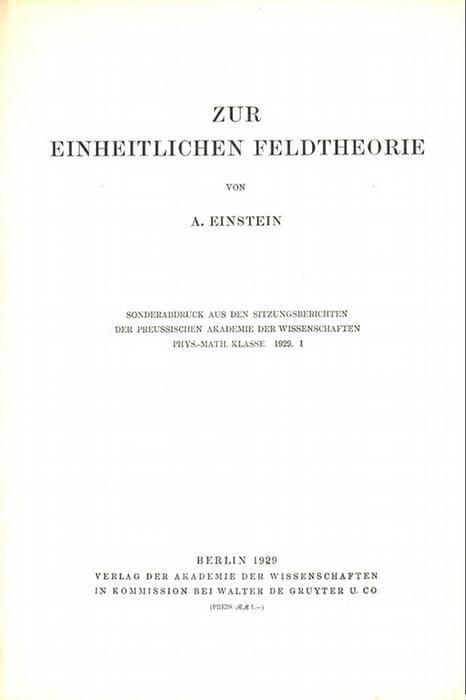Available Copies from Independent Booksellers

Price: US$750.00 + shipping
Description: Einstein, Albert (1879-1955). Zur einheitlichen Feldtheorie. Offprint from Sitzungsberichten der preussischen Akademie der Wissenschaften 1 (1929). 8vo. 8pp. Berlin: Verlag der Akademie der Wissenschaft, 1929. 256 x 183 mm. Original printed wrappers, slightly soiled and creased. Very good. First Separate Edition. "In 1928, [Einstein] embarked on a new approach to a unified field theory . . . involving what he called 'distant parallelism'. . . . By early 1929 he had solved the main problems involved in writing down field equations for his unified theory. On the day of official publication of the third of a formidably technical series of nine articles on the theory . . . excited headlines appeared in foreign newspapers throughout the world. . . . In this frenzied, unscientific atmosphere, Einstein's new theory was hailed in the press as an outstanding scientific advance. Yet Einstein had stated in his article that it was still tentative; and soon he found he had to abandon it (Hoffman, Einstein, pp. 225-26). This paper is included on Shields's list of Einstein's most significant papers; see Albert Einstein, Philosopher-Scientist (1949), p. 758. Weil 165. Pais, Subtle is the Lord, pp. 344-46. .
Seller: Jeremy Norman's historyofscience, Novato, CA, U.S.A.

Einstein, Albert. Zur Einheitlichen Feldtheorie.. , 1929.
Price: US$837.83 + shipping
Description: S.Ber. Akad. Wiss. Berl., 1929/ 1. - Berlin, Verlag der Akademie der Wissenschaften, 1930, 8°, 8 S., in schönem Pappband der Zeit. First Edition! "The unified Field Theory" is one of Einstein's last important scientific works. According to Weil "This paper represents a new development which was immediate news. A translation by L.L.Whyte appeared in the (London) Times of Feb. 4, 1929. It was quoted in full in "Observatory", vol. 52, under the title "New Field Theory" pp.82-87 and (1930) pp.11-118." In 1928 Einstein embarked on a new approach to a unified field theory . involving what he called 'distant parallelism' . By early 1929 he had solved the main problems involved in writing down field equations for his unified field theory. On the day of offical publication of the third of a formidably technical series of 9 articles on the theory . excited headlines appeared in foreign newspapers, throughout the world . In this frenzied, unscientific atmosphere Einstein's new theory was hailed in the press as an outstanding scientific advance. Yet Einstein had stated in his article it was still tentative; and soon he found he had to abandon it. - cf.Parkinson, Breakthroughs, p.279 Weil No. 165*, Schlipp, Einstein No.226; Alicke No. 141; Norman Coll. I, 700
Seller: Antiq. F.-D. Söhn - Medicusbooks.Com, Marburg, Germany

Price: US$1815.00 + shipping
Description: An important offprint, first edition. With mathematical formulas in text. Small folio, in the original orange off-print paper wrappers printed in black on both covers. 8 pp. Very fine, nearly as new. A RARE AND IMPORTANT OFFPRINT. EINHEITLICHEN FELDTHEORIE, which means "A Coherent Theory of the Electro-Magnetic Field" and is the title of a five-page paper of highest mathematical formulae which Relativist Albert Einstein worked on for ten years. His report is a purely mathematical extension of the general theory of relativity to include gravitational and electromagnetic phenomena. His relativity theory, which he phrased within only three printed pages, made time & space the creator of matter. When this paper on the Unified Field Theory was published, it was a headline story in the newspapers. Few, if any people, understood the complex mathematics, but many were fascinated by the thought that Einstein had possibly came up with a new theory, expanding on "General Relativity", and unifying the fundamental forces of nature. It is considered Einstein's last important scientific work (Weil #165). "In 1928, [Einstein] embarked on a new approach to a unified field theory. involving what he called 'distant parallelism'. By early 1929 he had solved the main problems involved in writing down field equations for his unified field theory. On the day of official publication of the third of a formidably technical series of nine articles on the theory. excited headlines appeared in foreign newspapers throughout the world. In this frenzied, unscientific atmosphere, Einstein's new theory was hailed in the press as an outstanding scientific advance. Yet Einstein had stated in his article that this was still tentative; and soon he found he had to abandon it" (Hoffmann/Dukas, ''Albert Einstein: Creator and Rebel'' (1972) pp. 225-226)
Seller: Buddenbrooks, Inc., Newburyport, MA, U.S.A.